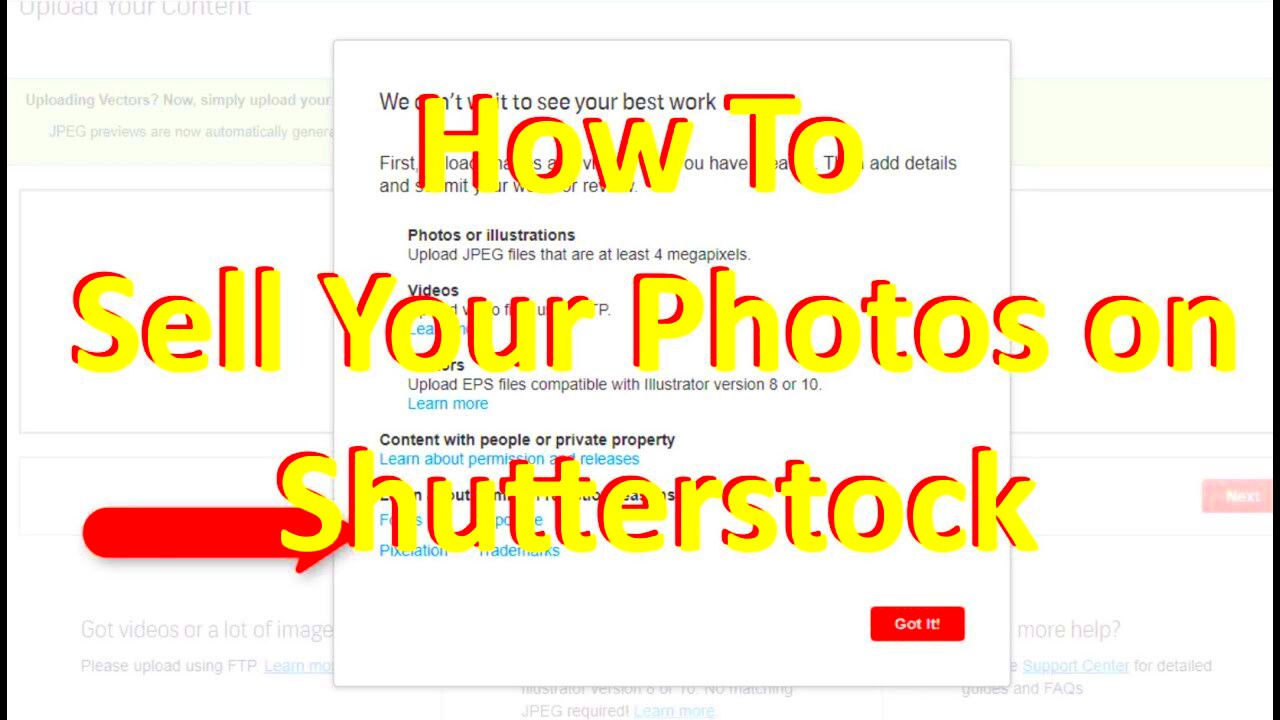Have you ever considered converting your interest in taking pictures into a means of making money? Selling your photos on sites such as
Shutterstock can be an interesting experience. The first time I uploaded my work, I felt both excited and anxious. It was palpable that I was already sharing my art with the global audience.Photographers are given this incredible chance to expose their work on
Shutterstock, but it is important that you know how to navigate through the website. Therefore, let us look into all there is to know about starting off down this road in this blog post.
Understanding the Shutterstock Platform
 Shutterstock
Shutterstock is an active market in which creative people from every corner of the world can engage in buying and selling images. However, what does it have that sets it apart from the rest? Here are some notable characteristics:
- Large Audience: With millions of users, your work can gain significant exposure.
- Diverse Categories: From nature to urban life, there’s a place for every style.
- User-Friendly Interface: The platform is designed to be easy to navigate, even for beginners.
- Global Reach: Your photos can be purchased by businesses, bloggers, and marketers worldwide.
Gaining knowledge about these facets can enhance your insight into the capability of this site. I remember feeling emancipated by the huge number of classes; it was possible to highlight anything from straightforward street photos to quiet countrysides. Each time I sent a new photograph, my attachment to the worldwide group of creators grew stronger.
Getting Started with Your Photographer Account

Creating an account with
Shutterstock is simple enough. Below are the guidelines to achieve this:
- Sign Up: Visit the Shutterstock website and click on the 'Sign Up' button. You can register using your email or social media accounts.
- Create Your Profile: Fill in your details and write a brief bio. This is your chance to let buyers know about your photography style and background.
- Submit Your Work: Once your account is active, start uploading your best images. Ensure they meet Shutterstock's guidelines.
- Stay Engaged: Check your account regularly for notifications and updates. This helps you stay informed about trends and sales.
Upon creating my account, it was as if an entrance into an entirely different universe had been unlocked. I spent so much time picking out suitable pictures to feature. Each of these images journeyed through my use of them as a photographer; they were told through their own respective narratives. The more you hang around with everyone else here patiently waiting for success, the quicker your individual sound will emerge quite distinct from others’.
Choosing the Right Photos to Upload

When discussing selling photographs on
Shutterstock, the choice of photographs could either break or make it all. My initial uploads are still fresh in my mind; they were very emotional moments. The joy of exposing myself was tamed within me by apprehension about rejection. What are some ways of choosing good images? Here are some suggestions:
- Focus on Quality: Always prioritize high-resolution images. A blurry or pixelated photo won't attract buyers.
- Know Your Audience: Research popular trends in stock photography. Images that cater to current themes are more likely to sell.
- Diversity is Key: Upload a variety of subjects—nature, people, architecture, and more. This broadens your appeal.
- Personal Connection: Choose photos that resonate with you personally. Your passion will shine through, making them more appealing.
Take this into account; each photograph narrates its own tale. The ones that I take while travelling or having quality time with friends and relatives are usually the best as far as I am concerned. Their authenticity expresses itself in real emotions captured in them and this is what resonates with prospective clients.
Optimizing Your Images for Better Sales
After you elect the photographs of your choice, it is time for optimizing them. The intention here is to make certain that not only will these pictures be attractive but they will also be different from all others in their segment. Consider these strategies:,
- Use Relevant Keywords: When uploading, include specific keywords that describe your photo. Think like a buyer—what terms would they search for?
- Write Compelling Descriptions: Along with keywords, provide a clear description of the image. Include details about the location, subject, and any relevant context.
- Image Editing: Enhance your photos with simple editing. Adjust brightness, contrast, and sharpness to make them pop.
- Consistent Style: Aim for a cohesive look across your portfolio. This helps create a recognizable brand that buyers can identify.
During the course of my career, I have learnt that an image hardens the war into a peace treaty. Sometimes what seems to be ordinary can turn out to be your best seller with just a little bit of editing and right keywords. It’s all about showing off your work in its best light—both literally and figuratively!
Setting Competitive Prices for Your Work
Adjusting rates for your images on
Shutterstock may seem challenging, specifically at the beginning. However, it is essential to achieve a margin that mirrors your excellence and attracts buyers' attention. Therefore, here how you can tackle pricing:
- Research Market Trends: Look at similar images to gauge what others are charging. This helps you understand the competitive landscape.
- Consider Your Experience: If you’re a beginner, you might want to start with lower prices. As you build your portfolio and reputation, you can gradually increase them.
- Assess Image Quality: High-quality, unique images can justify higher prices. If your work stands out, don’t be afraid to set a premium.
- Test and Adjust: Start with a price and monitor your sales. If certain images aren’t selling, consider lowering the price to attract more buyers.
On my way of experience, I have discovered that determining the price is a special skill of its own. In the beginning, I was not sure about anything and usually saw my labor as insufficiently paid. But then my confidence started growing, which caused changes to occur in me too. And when it came to pricing fairly, I found out it is about realizing how much value you have brought into your artistic works as well. Just bear in mind that for you photos are not images only but they represent your thoughts and efforts behind the camera.
Marketing Your Photography Effectively
When it comes to marketing your photography, it is important to consider ensuring that your images land in the right hands. There was a time when I would put my pictures on social media only to be ignored by most people. I started getting clicks and comments only after I learnt effective marketing strategies. Here is how you can effectively market yours:
- Leverage Social Media: Use platforms like Instagram, Facebook, and Pinterest to showcase your work. Share behind-the-scenes stories or tips to engage your audience.
- Join Photography Groups: Participate in online communities where you can share your work, receive feedback, and connect with potential buyers.
- Collaborate with Other Creatives: Partnering with other photographers or content creators can expand your reach. I once collaborated with a local travel blogger, which introduced my work to her followers.
- Create a Portfolio Website: Having a personal website acts as a digital business card. It allows potential buyers to view your work in one place and contact you easily.
Initially, marketing might appear to be quite difficult but you can look at it as sharing your story. All photographs have tales, which will capture your audience’s hearts when they are privy to it. Approach this as a journey and do not be shy to express who you really are!
FAQ About Selling on Shutterstock
The questions below may help clarify some questions you have about selling photography as you embark on this journey. They can be found in this FAQ section:
| Question | Answer |
|---|
| How much can I earn from Shutterstock? | Your earnings depend on the number of downloads and the licensing type. Some photographers earn a significant income, while others see it as a side hustle. |
| Do I need to be a professional photographer? | No, you don’t need to be a pro. Passionate amateurs can also find success if they focus on quality and unique perspectives. |
| How do I know if my photo will sell? | Research trends and pay attention to popular themes. Your unique viewpoint can also make ordinary subjects stand out. |
| What are the copyright rules? | Ensure you own the rights to the images you upload and that they comply with Shutterstock’s guidelines to avoid any issues. |
Getting answers to such questions would calm your nerves and also offer you a more visible way ahead. Don’t hesitate to reach out for help from colleagues; they might be of great assistance!
Conclusion and Final Thoughts
The experience of embarking on a photography selling journey is both a thrilling and somewhat daunting endeavor on Shutterstock. Personally, I have learnt that one does not succeed in this field within a day. It requires time, commitment and ability to change with time. Always remember that each photographer has their own distinctive appeal, yours included.Refining skills, establishing portfolio, and building community takes time. Whether it is your first sale or good review from another artist, appreciating the little victories helps one build character. Eventually, passion combined with determination transforms this love for photography into something fruitful.Well, are you prepared to show the world what you suppose of your dream? The odyssey is in motion, and I am so anxious to figure out its destination!
 Shutterstock is an active market in which creative people from every corner of the world can engage in buying and selling images. However, what does it have that sets it apart from the rest? Here are some notable characteristics:
Shutterstock is an active market in which creative people from every corner of the world can engage in buying and selling images. However, what does it have that sets it apart from the rest? Here are some notable characteristics: Creating an account with Shutterstock is simple enough. Below are the guidelines to achieve this:
Creating an account with Shutterstock is simple enough. Below are the guidelines to achieve this: When discussing selling photographs on Shutterstock, the choice of photographs could either break or make it all. My initial uploads are still fresh in my mind; they were very emotional moments. The joy of exposing myself was tamed within me by apprehension about rejection. What are some ways of choosing good images? Here are some suggestions:
When discussing selling photographs on Shutterstock, the choice of photographs could either break or make it all. My initial uploads are still fresh in my mind; they were very emotional moments. The joy of exposing myself was tamed within me by apprehension about rejection. What are some ways of choosing good images? Here are some suggestions:
 admin
admin








